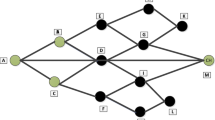Abstract
In sensor networks, the periodically aggregated data often exhibit high temporal coherency. Huge energy consumption incurred in transmitting these redundant information results in network disconnection thereby leading to service disruption. In order to effectively manage the energy consumption in concurrent data gathering rounds, temporal data prediction model is proposed. The proposed model provides near accurate predictions that successfully restricts redundant transmissions. The communication energy conserved owing to successful predictions helps to increase the number of data cycles considerably. In addition, an energy prediction-based cluster head rotation algorithm is also presented for load balancing within clusters. Experimental outcomes show that the proposed prediction model significantly improves energy conservation by providing successful predictions per data gathering cycle. Results reveal lower magnitude of prediction error as compared to certain existing prediction methods.











Similar content being viewed by others
References
Akkaya, K., Demirbas, M., & Aygun, R. S. (2008). The impact of data aggregation on the performance of wireless ssensor networks. Wireless Communications and Mobile Computing, 8, 171–193.
Rajagopalan, R., & Varshney, P. K. (2006). Data-aggregation techniques in sensor networks: A survey. IEEE Communications Surveys and Tutorials, 4th Quarter, 8(4), 48–63.
Chen, Y., Shu, J., Zhang, S., Liu, L., & Sun, L. (2009). Data fusion in wireless sensor networks. In IEEE second international symposium on electronic commerce and security, pp. 504–509.
Pal, R., Gupta, B., Prasad, N R., & Prasad, R. (2009). Efficient data processing in ultralow power wireless networks: Ideas from compressed sensing. In 2nd international symposium on applied sciences in biomedical and communication technologies, pp. 1–2.
Guo, W., Xiong, N., Vasilakos, A. V., Chen, G., & Cheng, H. (2011). Multi-source temporal data aggregation in wireless sensor networks. Wireless Personal Communications, 56, 359–370.
Chatterjea, S., Nieberg, T., Meratnia, N., & Havinga, P. (2008). A distributed and self-organizing scheduling algorithm for energy-efficient data aggregation in wireless sensor networks. ACM Transactions on Sensor Networks, 4(4), 20:1–20:41.
Kalpakis, K. (2010). Everywhere sparse approximately optimal minimum energy data gathering and aggregation in sensor networks. ACM Transaction on Sensor Network, 7(1), 9-2–9-26.
Boulis, A., Ganeriwal, S., & Srivastava, M. B. (2003). Aggregation in sensor networks: An energy–accuracy trade-off. Ad Hoc Networks, 1, 317–331.
Yao, Y., & Giannakis, B. B. (2005). Energy-efficient scheduling for wireless sensor networks. IEEE Transactions on Communications, 53(8), 54–61.
Wang, X., Ma, J.-J., Wang, S., & Bi, D.-W. (2007). Prediction-based dynamic energy management in wireless sensor networks. Sensors, 7, 251–266.
Zhao, J., Liu, H., Li, Z., & Li, W. (2013). Periodic data prediction algorithm in wireless sensor networks. Advances in Wireless Sensor Networks Communications in Computer and Information Science, 334, 695–701.
Borgnea, Y.-A. L., Santinib, S., & Bontempi, G. (2007). Adaptive model selection for time series prediction in wireless sensor networks. Signal Processing, 87(12), 3010–3020.
Hastie, T., Tibsharani, R., & Friedman, J. (2009). The elements of statistical learning: Data mining, inference, and prediction. New York: Springer.
Navon, I. M. (2009). Data Assimilation for numerical weather prediction: A review. In Data assimilation for atmospheric, oceanic and hydrologic applications, pp. 21–65.
Wang, G., Wang, H., Cao, J., & Guo, M. (2007). Energy-efficient dual prediction-based data gathering for environmental monitoring applications. In IEEE WCNC, pp. 3516–3521.
Blaß, E.-O., Horneber, J., & Zitterbart, M. (2008). Analyzing data prediction in wireless sensor networks. In IEEE vehicular technology conference, pp. 86–87.
Kang, J., Tang, L., Zuo, X., & Li, H. (2009). Grey kernel partial least squares-based prediction for temporal data aggregation in sensor networks. IEEE International Conference Intelligent Computing and Intelligent Systems, 3, 38–42.
Meng, L., Zhang, H., & Zou, Y. (2011). A data aggregation transfer protocol based on clustering and data prediction in wireless sensor networks. In 7th IEEE international conference on wireless communications, networking and mobile computing (WiCOM), pp. 1–5.
Jiang, H., Jin, S., & Wang, C. (2011). Prediction or not? An energy-efficient framework for clustering-based data collection in wireless sensor networks. IEEE Transactions on Parallel and Distributed Systems, 22(6), 1064–1071.
Tulone, D., & Madden, S. (2006). PAQ: Time series forecasting for approximate query answering in sensor networks. In 3rd European conference on wireless sensor networks, pp. 21–37.
Tulone, D., & Madden, S. (2006). An energy-efficient querying framework in sensor networks for detecting node similarities. In 9th international ACM symposium on modeling, analysis and simulation of wireless and mobile systems, pp. 291–300.
Wei, G., Ling, Y., Guo, B., Xiao, B., & Vasilakos, A. V. (2011). Prediction based data aggregation in wireless sensor network: Combining grey model and Kalman Filter. Computer Communications, 34, 793–802.
Edara, P., Limaye, A., & Ramamritham, K. (2008). Asynchronous in-network prediction: Efficient aggregation in sensor networks. ACM Transactions on Sensor Networks, 4(4), 25–34.
Sinha, A., & Lobiyal, D. K. (2014). Probabilistic data aggregation in information-based clustered sensor network. Wireless Personal Communications, 77(2), 1287–1310.
Fall, K., & Varadhan, K. (2009). The NS manual. The VINT project.
Altman, E., & Jemenez, T. (2003). NS simulator for beginners.
Issariyakul, T., & Hossain, E. (2009). Introduction to network simulator NS2.
Author information
Authors and Affiliations
Corresponding author
Rights and permissions
About this article
Cite this article
Sinha, A., Lobiyal, D.K. Prediction Models for Energy Efficient Data Aggregation in Wireless Sensor Network. Wireless Pers Commun 84, 1325–1343 (2015). https://doi.org/10.1007/s11277-015-2690-x
Published:
Issue Date:
DOI: https://doi.org/10.1007/s11277-015-2690-x




